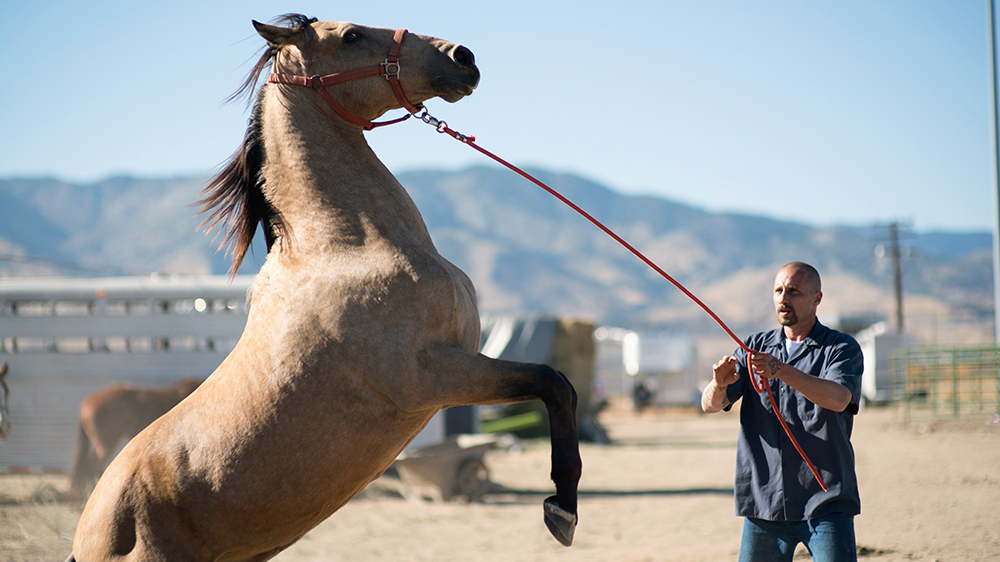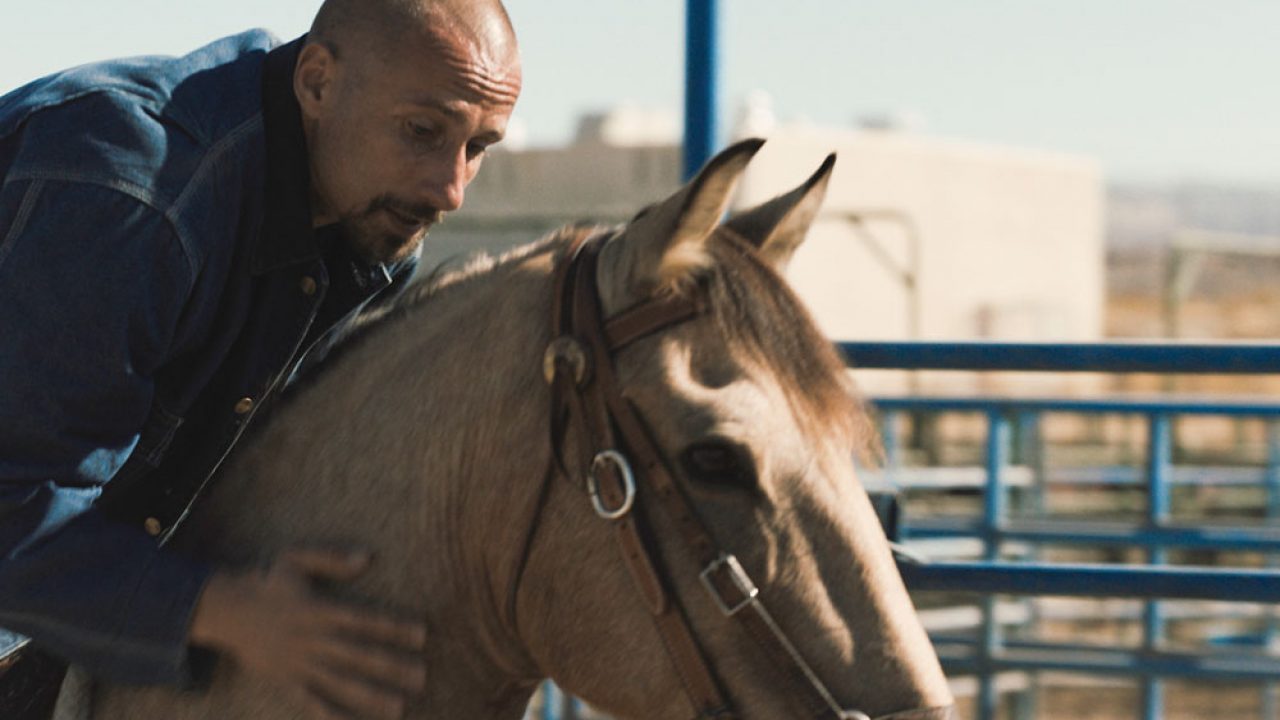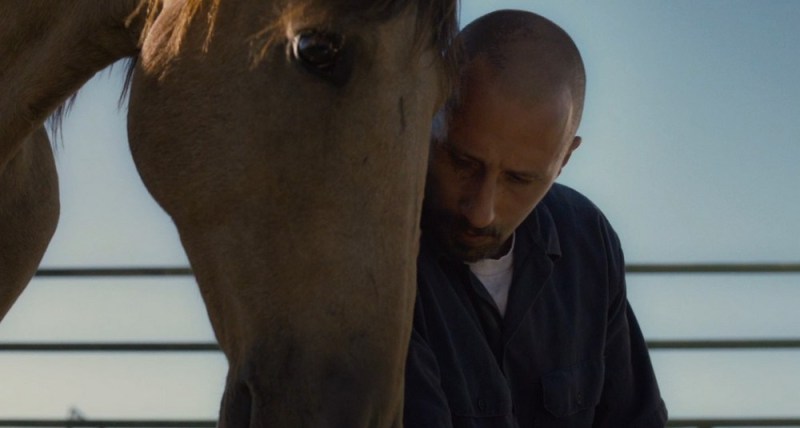‘The Mustang’ follows the story of Roman Coleman, who has been in prison for 12 years for violently attacking his partner, which left her permanently brain damaged. After a psychological evaluation, Roman is assigned to a unique rehabilitation program — one that tasks prisoners with training wild mustangs to make them more receptive to humans before they’re auctioned off. Directed by Laure de Clermont-Tonnerre, the film features the talents of Matthias Schoenaerts, Jason Mitchell, Gideon Adlon, Connie Britton, and Bruce Dern.
The realistic way in which incarceration and life in prison are approached in the film feels both genuine and gentle; it is to the point that the viewers can feel each and every emotion that passes between man and beast on screen quite distinctly. This true level of connection sparks curiosity about ‘The Mustang’s’ real-life ties. If you are curious about the same, then here’s everything that you need to know!
The Mustang: Fiction Inspired by Real Rehabilitation Program
No, ‘The Mustang’ is not based on a true story. However, the rehabilitation program that makes up the core of the story, penned by director Laure de Clermont-Tonnerre, is based on an actual program in Carson City, Nevada. It is a joint venture between the Bureau of Land Management and the Nevada Department of Corrections-Silver State Industries. It serves as both rehabilitation for minimum-security inmates and a way for the Bureau of Land Management to deal with an explosive wild Mustang population by training and auctioning them.

“The [rehabilitation] program has proven itself to be the most successful or one of the most successful rehabilitation programs in terms of, I mean, the percentage of recidivism is-is almost none. Because there’s a lot of programs — there’s art programs,…so many different types of programs depending on the facility and the state you’re in, but this very program has-has proven itself to be very efficient,” Matthias Schoenaerts said in an on-set interview with FilmIsNow Movie Bloopers & Extras on the rehabilitation program being run in Carson City, Nevada.
‘The Mustang’ beautifully shows the parallels between Roman Coleman (Matthias Schoenaerts) and the Mustang he is training. Both are violent and unpredictable and are confined inside because of their violent nature. But through rehabilitation, both of them can earn their freedom. The parallels aren’t limited to symbolism, however. The way in which Matthias depicts Roman, from his shuffling steps and reserved way of speaking to his grim expression, all remind the audience of an abused horse. Roman’s demeanor gradually changes as he interacts with his equestrian charge more and more.
“It’s a person who comes back to life. You know, he was alive but he was kind of dead, and-and, yeah long story short the horse brings him back to life. Brings him back to himself, brings him back to the others [around him]; brings back awareness, brings back reflection. You know, all these type of things. So yeah, he’s a changed person at the end for sure,” Matthias continued in the interview about his character, Roman, and his journey throughout ‘The Mustang.’

‘The Mustang’ also touches upon the subject of mental health and guilt. It is plainly obvious to the viewers that despite what Roman had done to warrant the severe punishment that has been meted out to him, he truly believes that he deserves it, preferring to stay alone than risk others’ safety by being around him. And all of these emotions are masterfully put on display by Matthias Schoenaerts. Through its portrayal of prison life as well, ‘The Mustang’ attempts to humanize the inmates and not just Roman.
To make the sequences involving the prison and its inmates, director Laure de Clermont-Tonnerre used the Nevada State Prison for filming. The prison had been shut down in 2012 and remains abandoned since then. The director spoke about the same in an interview with FilmIsNow Movie Bloopers & Extras. She said, “It was very very valuable for the story to be in this authentic element and I always wanted to be in an active prison for this film, for Mustang. And I really wanted to shoot in this prison with this [rehabilitation] program.”
Laure de Clermont-Tonnerre added, “So started conversation with, like, the correctional department and at the end it was very complicated to be in an active prison. But they [Nevada Department of Corrections]…they have here like this empty prison that they closed ten years ago and-and that was much easier and also because it’s so authentic because you feel like people were there yesterday. It was very helpful for us and for the actors to set up the right tone because there’s some things that you can’t build…the atmosphere that it [the prison] diffuses is inimitable.”
The bond between man and animal has always been strong. How somebody treats an animal under their charge is a reflection of who they are as a person. ‘The Mustang’ shows this quality in such a way that not only is it believable, but it also makes the audience empathize with the story and the characters as well.
Read More: Where Was The Mustang (2019) Filmed?


You must be logged in to post a comment.